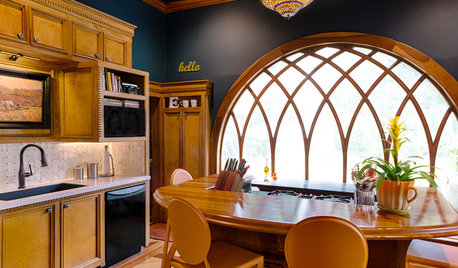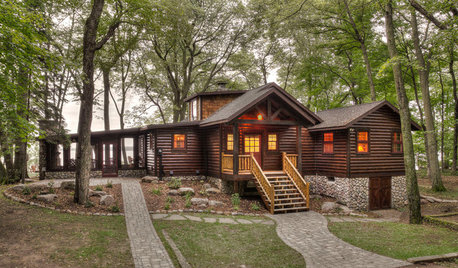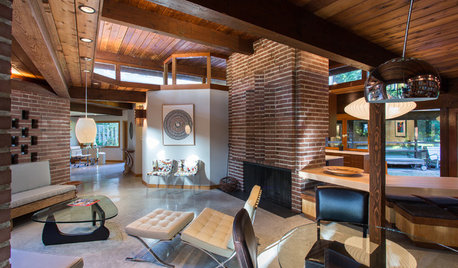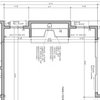best way to clear wooded land & preserve soil
If I were to buy a large (2-10 acres) wooded lot, but wish to clear it mostly/entirely before a build, what is the best method that will preserve as much of the topsoil as possible?
Most of the better sized lots I see in the areas I'd consider a build in are wooded. Which some find nice, I find annoying. To me, a large lot that is wooded is kinda pointless - you can't garden in the deep shade, it's ridden with mosquitos, there are no places to put a swimming pool, or place for the kids to play, etc. SOME woods might be nice, but not all of it.
So my thought was to buy a wooded lot, and clear most/all of it, so I can choose what I want to plant and where.
I hear the "pushover" method is bad for the soil - it compacts it, strips, etc.
Then I read about these "mulchers" that are basically giant brushcutters that mulch everything. These sound interesting, but, then you're left with these huge piles of wood chips that, while nice as mulch, would be hard to plant landscape plants and lawns in, plus, all you are doing is grinding the stump at ground level. You'll still have an unrotted stump instead of dirt everywhere a tree existed.
Now, when it comes to grading and building the actual house, some movement of dirt is unavoidable, but only in the footprint of the house, not the entirety of a large lot.
Can anyone share their experiences here?
Comments (25)
qbryant
10 years agoI would say save your time and money and buy pasture,I have a very wooded place that I'm clearing and I thank it's best done by hand(loppers and chainsaw),that way you don't mess up the root system of the trees you want to keep,I love the thick wooded setting with just enough cleared for a small yard around the house.
dekeoboe
10 years agoAnother woods lover here. You can garden in the shade and, as a kid, we liked playing in the woods. But as qbryant says, you are probably better off with pasture. It is probably less expensive in the long run. Have you ever seen a clear cut lot? It looks like crap and takes a lot of work and money to get it to look good.
We preserved as much top soil as possible where we cleared for the house by pulling up the stumps and knocking off the dirt. I wouldn't want to do that with 2-10 acres though. And, the woods are going to be reseeding themselves for a long time. Plus, the trees are holding the soil in place and you could end up with erosion problems once you remove them, especially if the land is hilly or sloped.
User
10 years agoIf you want a sunny lot, go buy a cow pasture or corn field. Clearing as much acreage as you're talking about isn't a DIY job unless you have YEARS of time. It's not even really a pro job, as they won't do it with an eye towards soil conservation. They'll tear out the trees and leave you to haul in some topsoil and grade it and tamp it down. THen you can hydroseed. All of which you can also pay for. And none of that labor is cheap. You'll end up paying more for that than you would if you just bought the more expensive lot that you desire in the first place.
virgilcarter
10 years agoWith your priorities and values, why don't you just buy cleared property?
Good luck with your project.
hairmetal4ever
Original Author10 years agoCleared/ex-farmland might be better, except it seems harder to find.
As far as gardening in the shade, sure, if all I want to grow are hostas. For fruits and veggies, that's a different story entirely.
Either way, it was more of a question of morbid curiosity. Thanks for the replies!
qbryant
10 years agoI am just clearing the area were the home will set and a small area around the house that we will sod,I want to be able to push mow in about 30 min.
The further you get away from the yard the thicker it gets.
Its 74 acres but I'm only working on about 8 acres and its a TON of work.zone4newby
10 years agoWe cleared maybe a half acre, and I don't think we lost lots of dirt, but what's there isn't anything I'd want to garden in. I hope to be able to grow grass in the clay, but we may need to bring in topsoil. I think that transitioning a large lot from woods to grass is going to be expensive and won't look good overnight.
Another advantage to holding out for a lot that's already cleared is that you'll have a much better idea of exactly what you're getting. It can be hard to see the contours of a wooded lot, but they will be obvious once the land is cleared.
Where are you building? Around here ex-farmland is much easier to find than wooded property. Almost everything was clear cut a hundred years ago or more.
Sarah80
10 years agoOur house was already built, but was only a few years old. We have a few acres, and our lot was mostly barren except grass.
However, our neighbor, who has a wooded lot, said our lot had been wooded, but the big trees were cut for timber by the last owner before it was subdivided (maybe 10-15 yrs ago), and all that was left were some black locust thickets, oak and hickory stump sprouts, Bradford pears, some buckthorn etc. So the last owner (who built the house) decided clearing was the best option at that point.
energy_rater_la
10 years agohostas are shade tolerant..the live fine in full sun.
(manyhosta taught me that!)my house sits in the middle of a pasture,
used to be horses here.
my biggest tree is the oak tree that I planted
15 years ago. it had finally gotten big
enough to provide enough shade for a small
table & 2 chairs.turning a pasture in to a yard...its a challange.
but fun. I have 2 large flower beds both with
trees..corkscrew willow in one, river birch in
the other. shrubs are great..witch hazel
bridal wreath, sweet olive.
but unless you buy large plants it will take
several years before the yard has a cohesive
look.bet of luck.
and btw...love you screen name.
hammer12345
10 years agoFor smaller trees I believe the buckthorn baggie would kill any tree under 4" diameter. You can just leave the roots behind and not disturb the soil.
LawPaw
10 years agoA dozer pushing over trees won't compact the soil much. Neither will an excavator. Track vehicles don't compact much.
If you are clearing the area, you won't need to worry about root damage to surrounding trees. Just dig a hole, push the trees in, and burn them. Or surface burn, level the ash, and bury the remaining stumps.
Awnmyown
10 years agoCleared 2 acres for my build out of a 10 acre solid bush. Found that the actually topsoil was fairly thin, and we cleared it all by hand and then just used a very small tractor (32 hp) with backhoe (18") to remove the stumps. It took 5 years to do, and *did* manage to preserve what soil was there AND not kill the surrounding vegetation. That being said, in the largest clearing which DOES get full sun in the summer, it's so drained from the big trees (and surrounding trees because their root systems are extensive), the grass even struggles to really grow well.
I also have 5 acres of ex-cattle pasture, that was de-bushed as you'd like about 15 years ago. The subsoil in this area which has been pasture grass for 15 years is STILL not sufficient to grow a good garden. My corn grew to about 22" last year...the farmers on the other hand had a beautiful corn crop. The trees and brush just alter the soil structure in a way that takes a long time to recoop. I work hard to till and add plenty of plant compost to try to help it along, but if you're hoping to clear without soil damage, build a house (which is a huge mess in itself) and get the land workable for gardening, give yourself 20 years.
That being said, a couple years with some goats and you can remove a ton of underbrush while enhancing the soil structure, get rid of poison ivy, and fertilize it to boot. Does a lovely job, doesn't compact the soil, and instead of fruit trees, you can make butter or meat...
LawPaw
10 years agoAwnmyown, your soil sounds like it has a nitrogen deficiency. Are you sure the plant material is fully composted when you work it in the soil? If it's not done composting when you work it in, it will actually absorb nitrogen from your soil making less nitrogen available to your plants.
It's common to grow a nitrogen fixing plant or cover crop before attempting to grow anything else. It's why beans are often the first crop grown on newly cleared land in ag. Is your soil sandy?
If your soil is sandy and leeches away nutrients, you can grow oats early fall to hold the nitrogen until spring. If you can get good oat growth by winter, you'll likely have enough nutrients for most plants when spring rolls around.
Grasses (corn is a grass) require a lot of nitrogen to do well, and they won't always yellow like other plants when their isn't enough nitrogen. Keep in mind that farmers add a lot of nitrogen to the soil to get good corn. Even excellent soil requires nitrogen amendment to grow bumper corn crops.
In my experience former pasture land, even if it's gone to brush, is highly productive ground (even for gardens, ect.). Normally I see former pasture ground outperform similar sites.
MFatt16
10 years agoCheck with local permitting too. We have acreage and were only allowed to clear a small percentage due to rules and regulations. Just an FYI.
nanj
10 years agoSaftgeek, what a neat idea! I saved your post for my files. Our land in SC has three pastures and a pond and this is a great idea for our back pasture. How do you sow the plants? Seeds? What part of the country are you in?
Thanks!
nanjsaftgeek
10 years agoNanj-
I live in Mo. We have a great state conservation agency and they have a lot of outreach stuff. I use my tractor to disc up the soil and then sow the seed with a seeder that straps over my shoulder. It takes a little longer but you get a great idea of the coverage and it's easy to regulate seed flow. You can learn a lot off of various forums, like Gardenweb.
Clover is planted in the winter, usually around the end of Feb or beginning of March. You do something called frost seeding, which is just letting the natural thawing set the seeds in the soil for you. Wheat is planted in the fall due to it's long growing season. It will sprout and stay green for all the deer and turkeys to feast on. Same goes for turnips and radish. These are planted by broadcast seeding and I usually only do the edges. They do great and once they freeze they turn sweet. That is when the deer start on them. Once the snow covers them the deer paw them out of the ground and eat them. Great forage when their natural foods are buried under the snow.
Good luck to you. You'll really enjoy seeing all the wildlife.
Saftgeek-
krisjb1
10 years agoI had two excavators come to give clearing estimates on my 1.5 acres. Maybe 3/4 acre would need clearing for an approximate 100X75 home footprint. I am planning for a 1 floor with walkout basement.
One excavator didn't have a clue on stump disposal and he never got back to me with a price. The other said he would knock over the trees and burn everything which upsets me as I hate to see that all go up in smoke. Besides, now is the bird nest season and the idea of killing all the wildlife is making me want to delay the whole thing until fall which is OK because I am not in a rush. Should I take the advice of the excavator and say that he can burn everything? Is there a good alternative?dekeoboe
10 years agoIs there a good alternative?
We also had about 3/4 acre cleaned. We have what is called a "Stump Dump" nearby. Our stumps and debris went there. Basically, everything goes in a big hole where it decomposes down.
saftgeek
10 years agoYou can pay to have stumps hauled away or you can bury them. One way they're someone else's problem and the other, they're your problem. It will take a long time for them to decompose, but they will. After a while the ground will settle where they're buried.
You can put an ad on Craigslist or another forum and offer your trees up as firewood. There are lots of folks looking for some place to cut wood. The big issue here is the liability. Before I let anyone do anything on my place I bought a liability policy. Now I'm covered if someone jumps my fence and falls off of the bluff I live on. Sounds ridiculous but I assure you it could happen.
The process of clearing land is pretty upsetting. I was pretty upset with myself when I initially started. I couldn't get over how long Mother Nature had taken to get the trees the size they were... When the Conservation Forester came over he actually congratulated me for clearing out so many of the non-essential trees. Elms, maples, cedar, and believe it or not Pecan were the ones he encouraged me to remove. I left the pecans, sassafras, white oak, red oak, and persimmon. All the others went. They were piled up and burnt. It was the only way to truly clear the ridge tops where animals had unimpeded access.
After my second or third round I had the dozer guy stack up the brush in the ditches and left them there for cover for rabbits and birds. They are ful of birds late in the evenings. I couldn't do that at first because my land was solid trees. I had to completely clear some areas before I had room for any brush piles.
You have to understand the bigger picture. No matter when you cut/clear you are going to upset nature. You just have to commit to putting it all back better than you found it.
Good luck...
Saftgeek-
LawPaw
10 years agoWe've done a good deal of clearing over the years. There is a big difference in stripping out an old growth forest and clearing out brush and "weed" trees. Most places, its natural for young growth to "burn out" occasionally. Sucker and colony trees, like Quaking Aspen, live mostly underground and will actually benefit from burning out the area and removing competition.
We found that the best way to handle stumps is to dig a deep hole (think 10 feet at least) and to push all the trees and brush into the hole with the stumps. The "earth" walls of the hole will insulate the fire and create a much hotter fire than a surface burn. This will significantly improve how much the brush and stumps burn down and shield the heat from surrounding flora (a hot surface burn can kill trees more than 20 feet away).
After the burn, fill in all but the top foot or so and compacting with the excavator bucket every couple of feet; then return the top soil and lightly compact. You will still get a depression over the next few years from the final decomposition.
I prefer to surface burn everything, then bury the stumps more than 6 feet deep. I even out the ash pile with a box scraper, then disc the soil before planting.
You need to bury the stumps below the frost line or else the frost may eventually return them to the surface before they fully compost.
As far as brush, remember the 2-2-2 rule; any branch or stick 2 inches or less in diameter within 2 inches of the ground should be decomposed within 2 years.
If you don't fully burn your brush pile, the decomposition may rob the soil of nitrogen and you won't get the growth you'd expect from deep rooted plants. You can tell if your having too much decomposition if you dig a post hole and it smells like manure.
Just to be safe I would plant an nitrogen fixing cover crop the first year. Talk to your conservation office to make sure the plants you put in aren't invasive in your area. Even native plants can be invasive or bad for your goals if left unchecked.
Also make sure you check with your local conservation people to see if there are any local disease problems to look out for. For example, I love black cherry and its a good conservation tree for North Iowa, but my particular area has a lot of a black knot fungus that makes it a poor choice for dense planting.
krisjb1
10 years agoThese are some good ideas that I had not really considered. Saftgeek I liked the idea of putting some brush out for small animal cover. It might help me feel a bit better about "wrecking stuff." I will definitely ask that the burn be put into a pit, Lawpaw5 as that seems to be a good way not to damage the surrounding vegetation. I can't say that I feel good about seeing some really old trees go in any case. I just might get Craigslist people to "come on in" and cut some firewood, and I have to get insurance for the build anyway-just not sure whether that sort of thing is covered. I have personal liability right now with a pretty high value, but after all is said, no one wants to be sued especially for a good deed. Free firewood could turn into a nightmare-need to check further on that, as the people removing the wood would not be contractors or builders but invited members of the public.
danman
9 years agoI bought a 2 acre wooded lot in a northern Minnesota with sandy loam soil. The undergrowth is not thick but there are saplings, shrubs and whatever kind of green non-woody plants, ferns and such. The small stuff, up to 2" in diameter, I'm using a leverage based hand tool to pull things up by the roots called a "Brush Grubber". I will clear a building site and a drive. Grading will require heavy equipment. a utility tractor with back blade and front end loader would be less destructive compared to a bulldozer but, we'll play it by ear. The small trees and brush are being removed by hand. Larger trees will be skidded out and cut for firewood. Fortunately I have lots of help, nieces, nephews, grandkids etc. My pickup, a four wheeler, chainsaws etc. along with other logging and grubbing tools help. I am plugging along steadily but surely to a set goal.




















saftgeek